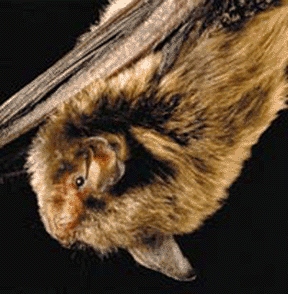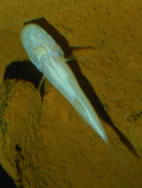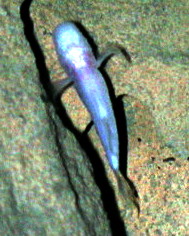The northern cavefish or northern blindfish is found in caves through Kentucky and southern Indiana. It is under review for possible listing under the Endangered Species Act of 1973 in the United States as of 2023, and the IUCN lists the species as near threatened.
The Percopsiformes are a small order of ray-finned fishes, comprising the trout-perch and its allies. It contains just ten extant species, grouped into seven genera and three families. Five of these genera are monotypic.

The Amblyopsidae are a fish family commonly referred to as cavefish, blindfish, or swampfish. They are small freshwater fish found in the dark environments of caves, springs and swamps in the eastern half of the United States. Like other troglobites, most amblyopsids exhibit adaptations to these dark environments, including the lack of functional eyes and the absence of pigmentation. More than 200 species of cavefishes are known, but only six of these are in the family Amblyopsidae. One of these, Forbesichthys agassizii, spends time both underground and aboveground. A seventh species in this family, Chologaster cornuta, is not a cave-dweller but lives in aboveground swamps.

The Ozark cavefish, Amblyopsis rosae, is a small subterranean freshwater fish endemic to the United States. It has been listed as a threatened species in the US since 1984; the IUCN currently lists the species as Near Threatened, though it was previously listed as Vulnerable between 1986 and 1996. It is listed as Endangered and Threatened by the Missouri Department of Conservation.

The Indiana bat is a medium-sized mouse-eared bat native to North America. It lives primarily in Southern and Midwestern U.S. states and is listed as an endangered species. The Indiana bat is grey, black, or chestnut in color and is 1.2–2.0 in long and weighs 4.5–9.5 g (0.16–0.34 oz). It is similar in appearance to the more common little brown bat, but is distinguished by its feet size, toe hair length, pink lips, and a keel on the calcar.

The Alabama cavefish is a critically endangered species of amblyopsid cavefish found only in underground pools in Key Cave, located in northwestern Alabama, United States in the Key Cave National Wildlife Refuge. It was discovered underneath a colony of gray bats in 1967 by researchers Robert A. Kuehne and John E. Cooper and scientifically described in 1974.
A blind fish is a fish without functional eyes. Most blind fish species are found in dark habitats such as the deep ocean, deep river channels and underground.

The blind cave eel is a species of cavefish in the family Synbranchidae. It is the longest cavefish in Australia and one of the only three vertebrates in Australia that is restricted to underground waters, the other being the blind gudgeon and the Barrow cave gudgeon. It is blind, its body is eel-like and elongated, and it has a non-pigmented skin with colours ranging from white to pink.
The juil ciego or blindwhiskered catfish is a species of three-barbeled catfish endemic to Mexico. This species is troglobitic, inhabiting a certain stream that flows through a single cave system.

Typhlichthys subterraneus, the southern cavefish, is a species of cavefish in the family Amblyopsidae endemic to karst regions of the eastern United States.

Cavefish or cave fish is a generic term for fresh and brackish water fish adapted to life in caves and other underground habitats. Related terms are subterranean fish, troglomorphic fish, troglobitic fish, stygobitic fish, phreatic fish and hypogean fish.

The golden topminnow is a fish of the genus Fundulus and is a United States native fish mostly distributed throughout the southeast, ranging from Kentucky and Ohio south into Florida. Although it has such a wide distribution throughout the south, the habitats and micro-habitats that it occupies do not differ much from one area of distribution to others. The golden topminnow is a small surface feeding fish that tends to reproduce late in the spring season and on into the early parts of the summer, and although the fry reach maturity fairly quickly the longevity of the golden topminnow is quite short. Because the golden topminnow is lower in the trophic level and is a small fish, it primarily feeds on small and/or drifting organisms at, or near the surface of, vegetated areas. This particular topminnow is not currently listed as an endangered species, nor does it have any particular type of management plan.

The spotted sucker is a species of sucker (fish) that is native to eastern North America. The spotted sucker inhabits deep pools of small to medium rivers over clay, sand or gravel. They are occasionally found in creeks and large rivers. Through its life stages, the spotted sucker goes from a mid-depth predator to a bottom forager. Spotted suckers have a lifespan of approximately six years and spawn in April and May. Limited knowledge of the occurrence, abundance, and natural history of this species has been an impediment to status assessment and the determination of need for conservation measures within this family.

Silverjaw minnows are part of the family Cyprinidae, which includes carps and minnows. With over 300 known species, there are more species of minnows native to North America's fresh waters than any other fish. Minnows can be hard to distinguish because many look alike. All minnows have one dorsal fin, ventral fins near the anus, a lateral line system, and smooth, round cycloid scales. Their jaws lack teeth, but they have one to three rows of pharyngeal teeth to grind food. Defining physical characteristics such as the number and type of fin rays, type of scales, and pattern of pharyngeal teeth are used to distinguish minnows.

The northern studfish is the largest of the killifish and is native to the southcentral United States.

The orangefin darter is a species of freshwater ray-finned fish, a darter from the subfamily Etheostomatinae, part of the family Percidae, which also contains the perches, ruffes and pikeperches. It is found in Barren River and Green River systems in Tennessee and Kentucky.

The swamp darter is a species of freshwater ray-finned fish, a darter from the subfamily Etheostomatinae, part of the family Percidae, which also contains the perches, ruffes and pikeperches. It is endemic to the Eastern United States.
The stripetail darter is a species of freshwater ray-finned fish, a darter from the subfamily Etheostomatinae, part of the family Percidae, which also contains the perches, ruffes and pikeperches. It is endemic to the eastern United States. It is found in small rivers and streams in the states of Tennessee, Ohio, Kentucky, Illinois, Alabama, Georgia, and Mississippi. Males are a golden-orange color with black barring on the fins, and grow to a length of about 2.8 in (7 cm). This fish feeds on midge larvae and other small invertebrates. It breeds in the spring; eggs are attached to the substrate, often under slab rocks, where they are guarded by the male. The population trend of this fish seems to be stable and it is a common species with numerous sub-populations over a wide range, and the International Union for Conservation of Nature has assessed its conservation status as being of "least concern".

Amblyopsis is a genus of small fish in the family Amblyopsidae that are endemic to the central and eastern United States. Like other cavefish, they lack pigmentation and are blind. The most recently described species was in 2014. Uniquely among fish, Amblyopsis brood their eggs in the gill chambers. It was formerly incorrectly speculated that the same brooding behavior existed in other genera in the family and in the pirate perch. During the Pleistocene period, the modern Ohio river was a barrier of dispersal and created a great genetic variation, leading to two phylogenetically distinct lineages from the species Amblyopsis.

The Hoosier cavefish is a subterranean species of blind fish from southern Indiana in the United States. Described in 2014, A. hoosieri was the first new species of amblyopsid cavefish to be discovered in 40 years.














